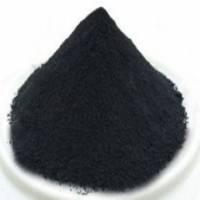Professional industry ceramic supplier, silicon nitride, silicon carbide, aluminum nitride and any other kinds of ceramics.
Iron oxide is an inorganic substance with a chemical formula of Fe3O4. It is a kind of magnetic black crystal, so it is also called magnetic iron oxide.

Iron oxide Fe3O4 powder properties
Iron oxide is insoluble in organic solvents such as water, alkaline solutions, ethanol and ether. The natural ferric oxide is insoluble in acid solution and is easily oxidized to iron oxide (Fe2O3) in humid air.
Black Fe3O4 is a mixed valence oxide of iron with a melting point of 1597°C and a density of 5.18g/cm3. Fe3O4 powder is insoluble in water but soluble in acid solution. It appears in the form of magnetite in nature at room temperature. It has strong submagnetism and high conductivity.
Fe3O4 has anti-corrosion effect. For example, the bluing of steel parts (also known as burning blue, baking blue) is to use the oxidation effect of alkaline oxidizing solution to form a blue-black or dark blue Fe3O4 film on the surface of the steel parts. Used to increase corrosion resistance, gloss and aesthetics.
Preparation of iron oxide Fe3O4 powder
The traditional methods for preparing nano-Fe3O4 mainly include precipitation method, hydrothermal (solvothermal) method, microemulsification method and sol-gel method.
1. Precipitation method
The precipitation method has simple operation, low cost, high product purity, and uniform composition. It is the most commonly used method for preparing nanoparticles and is suitable for large-scale production. Common precipitation methods include co-precipitation, hydrolytic precipitation, ultrasonic precipitation, alkoxide hydrolysis and chelate decomposition.
2. Hydrothermal (solvothermal) method
Hydrothermal (solvothermal) reaction is a general term for chemical reactions carried out in fluids such as aqueous solutions (organic solvents) or steam at high temperature and pressure. The Fe3O4 prepared by the hydrothermal method has small particle size and relatively uniform particle size, does not require high-temperature calcination pretreatment, and can realize the doping of multivalent ions.
3. Microemulsification method
Microemulsification refers to the formation of an emulsion by two immiscible solvents under the action of surfactants, that is, amphiphilic molecules divide the continuous medium into tiny spaces to form a microreactor, in which the reactants react to form a solid phase. The processes of nucleation, crystal growth, coalescence, and agglomeration are restricted by the microreactor to form nanoparticles with a certain cohesive structure and morphology wrapped by a layer of surfactant.
4. Sol-gel method
The method utilizes the hydrolysis and polymerization of metal alkoxides to prepare a uniform sol of metal oxide or metal hydroxide, and then concentrates it into a transparent gel. The gel is dried and heat-treated to obtain ultrafine oxide powder.
Overview of iron oxide Fe3O4
Iron oxide (II, III) (Fe3O4) iron oxide can also be made into particles, blocks, powders, sputtering targets, tablets and nano-powders. In most cases, iron oxide is usually available immediately. High-purity, sub-micron and nano-powder forms can be considered. Provide other technical, research, and security (MSDS) information. Fe3O4 is formed by Schikorr reaction. This reaction converts iron (II) hydroxide (Fe(OH)2) to iron oxide (II,III) (Fe3O4). Under anaerobic conditions, ferrous hydroxide (Fe(OH)2) is oxidized in water to form magnetite and molecular hydrogen. Skicor's reaction explained the process.
3Fe(OH)2 → Fe3O4 + H2 + 2H2O
Hydroxide magnetite hydrogen water.
Application of iron oxide Fe3O4
Iron oxide Fe3O4 powder, usually called iron oxide black, magnetite and iron oxide black, can be used in many different fields, for example: iron oxide (II, III) is used as a black pigment, also known as Martian black.
Used as a catalyst in the Haber process.
Used for water gas shift reaction.
In contrast, Fe3O4 nanoparticles are used for MRI scans.
It can prevent steel from rusting.
It is a component in aluminate, used for cutting steel.
Iron oxide Fe3O4 powder is ferromagnetic. If the radius of the formed particles is at the nanometer level, they are called ferromagnetic particles.
1. It can produce magnetic recording materials, high gradient magnetic separators, wave absorbing materials, and special coatings.
2. It is widely used as a carrier of various pharmaceutical ingredients to form a magnetic targeted drug delivery system; used for the separation of magnetic immune cells and nuclear magnetic resonance imaging.
3. Used for precision instruments, gas sealing, vacuum sealing, etc.
Iron oxide Fe3O4 price
The price of iron oxide Fe3O4 powder will vary randomly with factors such as production cost, transportation cost, international situation, and market supply and demand of iron oxide Fe3O4 powder. Tianki New Materials Co., Ltd. aims to help various industries and chemical wholesalers find high-quality, low-cost nanomaterials and chemicals by providing a full set of customized services. If you are looking for iron oxide Fe3O4 powder, please feel free to send an inquiry to get the latest price. Iron oxide Fe3O4 powder
Suppliers of iron oxide Fe3O4
As a global supplier of iron oxide Fe3O4, Tanki New Materials Co., Ltd. has extensive experience in the performance, application and cost-effective manufacturing of advanced engineering materials. The company has successfully developed a series of powder materials (including boron carbide, aluminum carbide, titanium carbide, etc.), high-purity targets, functional ceramics and structural devices, and provides OEM services.
| Technical Parameter of Iron Oxide Fe3O4 Powder: | ||
| Test item | 01 | 2 |
| Content Fe3O4≥﹪ | 99 | 99 |
| Moisture content ≤﹪ | 0.7 | 0.7 |
| Water Soluble ≤﹪ | 0.4 | 0.4 |
| Residue On Sieve(325mesh) | 0.3 | 0.3 |
| Oil absorption (ml/100g) | 21 | 21 |
| PH value | 7 | 7 |
| Tinting strength ﹪ | 99 | 99 |
